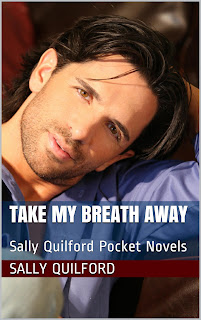As a writer of romantic intrigue, my work includes two very
big themes; love and death. The love is, of course, the romance. The death,
usually a murder, is very often the catalyst that brings the hero and heroine
together. There may also be the fear of death, as there is in my book Midnight Train, where a group of people
are stuck on a runaway train bearing a nuclear device. Having a hero and heroine have to cling on to each other during a shoot out is a great way of bringing them together!
The main problem is how to deal with death in what is
essentially a light romance. The death,
like any conflict, has to have some bearing on the overall story. However, it
cannot be so close to the hero or heroine that it would be unrealistic for them
not to grieve for a while. In one of my stories (unpublished) I wanted to kill
off the heroine’s father partway through the story, but it occurred to me that
if I did that, it would change the tone of the story completely. She would be
too busy grieving for her father to fall in love, and if I rushed it, and had
her suddenly get over her father’s death within days, then she would not be the
heroine I had envisaged. For that reason, if heroines in my other stories have
dead parents, I make their deaths happen sometime in the shadowy past. That way
she can still be sorry she’s lost them, but she’s over the worst of the grief.
Writing a murder into a love story is usually a bit easier,
as it’s often a person that no one much likes, but who is connected to the hero
and/or heroine in some way that puts doubts on their relationship. Or they
disagree over the best way to deal with the murder. Or the murder just brings
them together to investigate; anything that ties the death/conflict to the
story. I bucked this trend in Take MyBreath Away by having the first murder victim as the rather likeable, but
hell-raising, ex-husband of my heroine, Patty Carter (I’m not giving anything
away here, it’s all in the first chapter!). However, whilst Patty mourned his
death, they had been split up long enough for her not to grieve in the same way
as if they’d had a long and happy marriage. So she is able to move on and connect
with the new hero in her life. The conflict comes from the hero thinking that
she’s the killer and what he’s going to do about it if that turns out to be
true. The important thing is that the reader is not dragged down by the
characters’ misery and grief.
There is a place for a more thoughtful and deep exploration
of love and death, but do remember we’re writing light romance here (or if you’re
not already writing it, you’re reading this blog because you may want to).
You could get over the issue of grieving over a death that
happens in the course of the story by having a time lapse of several weeks or
months. On the other hand, you don’t want them dealing with the loss of a close
loved one by recovering within days or in a time that seems too short to be
realistic to the reader.
A participant in one of my workshops had a scenario where
the hero’s wife had died just six months before he met the heroine. Now I know
that in real life people no longer wait a ‘respectable’ year before becoming
romantically involved with others, or even in getting married again (my
step-father moved his new girlfriend in on the night of my mother’s funeral!) but
in fiction, unless the hero’s wife was a real bitch, it would seem callous that
he suddenly found himself in love with another woman so soon after losing his
wife. Six months, for most people, is not enough to come to terms with the loss
of someone you loved dearly. I suggested to the writer that she makes it at
least a year, and possibly more since the first wife died, just to put that little
bit more distance between the death and the new romance. The hero could still
have the same doubts, and fear that he’s being unfaithful to the memory of his
first wife, but it tones down the angst a few notches so that the reader doesn’t
feel as though they’re drowning in tears.
One of my favourite books by Kate Walker examines the
feelings of a widower finding a new woman to love after the death of his wife,
but it’s been a while since the wife died, so the story isn’t bogged down by
his grief, even if he does have lots of feelings of guilt. What I particularly
liked was that Kate didn’t feel the need to demonise the wife to make the
heroine seem more important in the hero’s life.
So you can write about love and death, but if you want to
write light fiction, you need to use a lighter touch; one that doesn’t
undermine the sadness of death, but which also doesn’t make the reader feel like
slitting their wrists after five pages of the heroine lying on her bed thinking
about what a vale of tears her life has turned out to be.






